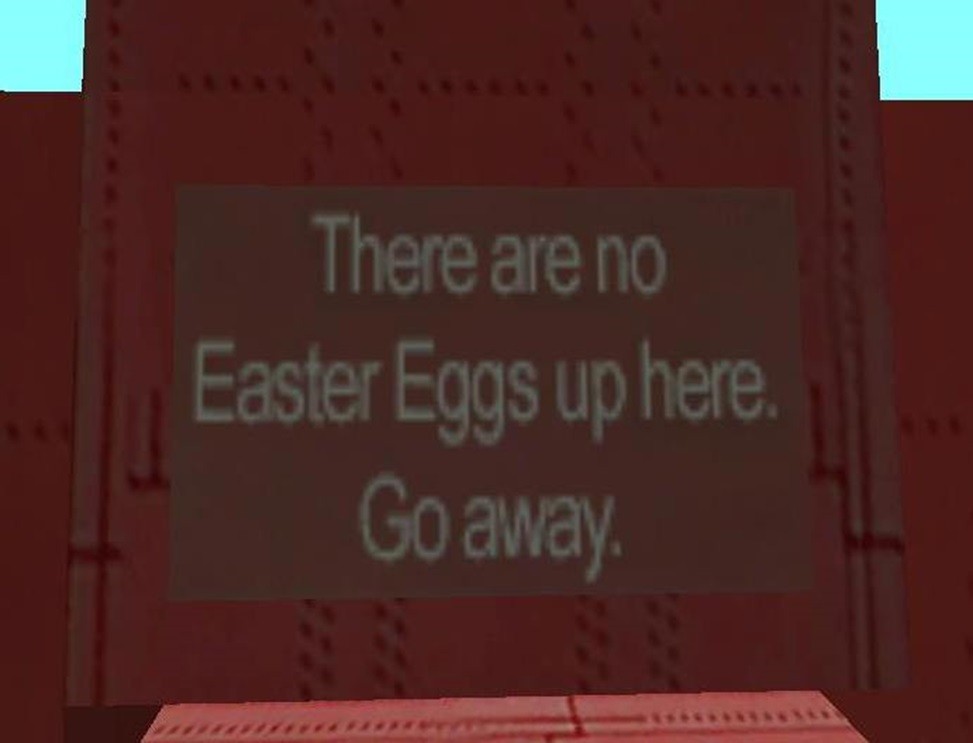is part of the Informa Markets Division of Informa PLC
This site is operated by a business or businesses owned by Informa PLC and all copyright resides with them. Informa PLC's registered office is 5 Howick Place, London SW1P 1WG. Registered in England and Wales. Number 8860726.
THE MISCONCEPTION AND HOW IT AFFECTS PLAYERS
With every physical form of media in the world, comes the opportunity to explore beyond the limits of said physical form. The most common form of his idea is through cinema. Critics explore the idea of what goes on beyond the screen; whether it is the behind the scenes footage or the gaps/plot holes left behind by a movie. The audience is forced to imagine and construct their own reality in their mind in regards to missing content within a movie. Similarly, a video game, while being the most interactive form of media, poses a similar situation. Most video games provide gamers with closure; however, some video games have open endings/bad endings and therefore have more to be desired from. With this concept of wanting more from a form of interactive media, the audience starts looking for clues to anything that might add to the experience or story. In terms of movies, the audience looks for clues left behind by characters that might suggest a historic background for an event in the story. Similarly, in video games, references are often delighted upon by players. The idea of being able to pick up on clues left behind in movies or in video games allows players/the audience to create their own world and their own interpretation of the events within a world. This brought about the creation of easter eggs and as with everything else in the world, with the interaction between players, video games myths came to be.
Since the invention of video games, developers and designers have secretly designed elements to be included in video games. This under the radar work is usually done in order to either entice video game players to clock in hours of gameplay to earn “rewards” after the main game is over or as a rebellious act from the designer/developer. The concept of easter eggs started when game designer Warren Robinett secretly added his credentials to the Atari game Adventure. Due to the nature of Atari games in the 1970s, where creators were not allowed to showcase their names within the game, Warren Robinett secretly coded a new level that would allow players to see “Created by Warren Robinett” as a game level. The concept of getting the player to work for the extra content is what makes easter eggs so enticing. In Adventure’s case; inside the black castle catacombs (on difficulty level 2 or 3), embedded in the south wall of a sealed chamber (accessible only with the bridge) in an invisible 1 pixel object referred to as the gray dot. The player must bounce the cursor along the bottom wall to grab the dot. The dot is not actually invisible, but simply the same color as the wall and is easily seen when placed in a catacombs passage or over a normal wall. The dot is not attracted to the magnet, unlike most other objects in Adventure. Bringing this dot to the easy end of the corridor below the golden castle while other differently colored objects are present causes the wall object to also become invisible, allowing the player to pass into a room displaying the words “Created by Warren Robinett” (Hague, James. "Halcyon Days: Warren Robinett".).

This easter egg started a trend in video games, that would later diverge into myths. Easter eggs and myths are closely related however, not ecessarily the same. The difference between the two is quite significant however closely related they are. A myth is basically an unproven easter egg. While most gamers will fantasize about the presence of certain elements in video games, they turn out to be untrue most of the time; basically a fabrication of their imagination. Gamers spend ungodly amounts of hours looking for objects and items that will add to the gameplay experience and whatever they find is instantly shared through the media. With the increasing technology, myths have reduced over the years due to the social exposure they get through social media. As soon as a gamer discovers something, their first action is to inform the gaming community about their find. This either ends up being a positive thing for some players while some manage to fall for the lies fabricated over the internet. Social media has increased the probability of people hiding behind screens and posting fabricated easter eggs on the internet, which when exposed becomes a myth. Something that no gamer can acquire unless they cheat using cheet code devices. A few games that gained popular recognition for easter eggs and myths at the same time are Final Fantasy VII, Grand Theft Auto: San Andreas and Pokemon.
While Pokemon and Final Fantasy VII are somewhat relative in terms of gameplay and genre, Grand Theft Auto: San Andreas is a completely different genre and utilizes a very different form of gameplay. So what makes these three games so popular and prone to myths and easter eggs? The concept of open world games is the common factor between these three games. All three games utilize a map that is free roam, allowing the player to explore within the constraints of the world map. Unlike most other games that are straight forward and provide the player with instructions on what to accomplish in the storyline, all three of these games give the player full control on what to do in the game when they want to. Ofcourse, there is a limit to that, as some areas are locked until a certain criteria is met, either in the story or in the gameplay, but most players come across easter eggs and myths in post-game, where every criteria in the main story has been met, allowing the player full control of the game. This provides the player the opportunity to explore areas without restrictions and boundaries, therefore, the more ground there is to cover, the more nonlinear a game is. Nonlinear games are more prone to myths because no two players can accomplish the same set of instructions by accident at first. Myths and easter eggs start appearing within the first few days of the release of the game and are slowly debunked over the years when gamers start catching up to them. This cycle is probably created as the following: A gamer plays the game, finishes it, proceeds to play post-game, runs out of things to do in the game and then proceeds to fabricate his version of “what could happen” in the game as opposed to “what seems plausible and realistic”. Over the years, all three games have gained a cult following, almost to the extent where all three games are atleast 10 years old and are still considered some of the best games of all time. This is another factor that plays into account when looking at what acts as a catalyst for myths and easter eggs. Famous games, that are usually part of a series, attract a lot of gamers, whether they are interested in the franchise or not. The clash of fan boys versus newcomers also leads to the creation of myths, in order to misguide the newcomers. Taking a case by case situation into account, all three games have had a severe impact on the gaming community, ranging from emotional breakdowns to downright expression through profanity. Each game has offered an epic storyline that has stuck with gamers over the years thus creating a cult following.
Starting off with the most recent game due to the exposure it has received by being created in the era when internet was widely available, Grand Theft Auto: San Andreas is an open world action-adventure game released in 2004, developed by Rockstar North and published by Rockstar Games and released for the Playstation 2 and the Xbox originally. Grand Theft Auto: San Andreas is the eight installment in the GTA franchise thus giving it an edge in the market as opposed to other games because of its successful predecessors. It is also the third 3D environment video game created in the GTA franchise. Like its predecessors, GTA: San Andreas is composed of elements from driving games and third person shooters and as stated before, features open world gameplay, in which players can interact with the world at their leisure. The story of the game revolves around Carl Johnson who returns home to Los Santos (fictional city in the game based on Los Angeles) after learning that his mother has been murdered. The discovery of easter eggs in the game started a few days after the game was released, allowing the players a certain amount of time to complete the main story. The easter eggs found in GTA: San Andreas were not ground breaking, however, they were a nod towards the existence of the previous installments and also to certain real life aspects along with other forms of media. One easter egg that has been a continuing gag in the GTA franchise is the board that says “There are no easter eggs up here. Go away.” All GTA games so far have incorporated that easter eggs into the open world. This is the first easter egg that players are keen to look for. This can be accessed by heading to Gant Bridge where the sign looks like follows:

While the easter eggs in Grand Theft Auto: San Andreas are not controversial to spike enough attention from critics, certain mods and myths have surfaced over the years, that speculated whether it was appropriate for teenagers to be exposed to a game like this. The first myth that the entire gaming community is prone to fall victim to is the existence of “big foot” in the game (Cracked.com, “21 video game myths easter eggs you won’t believe are true”). This specific easter egg had gamers going around in circles in the open world game. The big foot was speculated to be found within the wilderness in a random spot. The world map of San Andreas was the largest open world map at the time of its release, therefore exploring every single corner of the open world was impossible and not to mention time consuming. A lot of players spent hours and hours looking for big foot, which ironically mirrors the myth in real life for the believers of the big foot myth; eventually giving up. Big foot did not exist within the game, or atleast not in the console version (Davis, Ian. “GTA: San Andreas big foot rumors persist). Big foot was a fabrication created by some players that saw an NPC in the woods and hysterically believed it to be big foot. However, in order to make the rumor true, players produced a modification for the PC version of the game. By installing this modification, the player can locate big foot and choose to kill it and encountering it is rather easy as opposed to the non-existent version in the original game. Another myth that became a subject of controversy in GTA:San Andreas was what became known as the “Hot Coffee Mod”. This patch was released in June 2005 allowing players to be exposed to a mini game involving sexual intercourse. It was believed that the mod was not started from scratch as modding of that level would be impossible for someone on the outside of the company. Therefore this mod was already present in the game but was exploited by Patrick Wildenborg, a 38 year old modder from Netherlands. The existence of this mod caused severe controversy in the gaming universe. The game was taken off shelves because of the increase in rating from Mature to Adults Only. This made GTA: San Andreas the only game to be mass-released with an Adults Only ESRB rating. Production of the version that included the mod was halted along with the removal of the already existing copies in stores all over the world. This resulted in a decline of sales for the game, going as far not being allowed to be sold in Australia due to the sudden increase in rating. This was cleared up by Rockstar North releasing a patch that cancelled out the previous one. This patch was called “Cold Coffee”, allowing the game to return to its original ESRB rating; mature. However, the mod still exists today and is used by players all over the world at their own expense (Olson, Bloise. “National Institute on Media and the Family Warns Parents of Secret GTA San Andreas content”)
The next game in chronological order is Final Fantasy VII. Final Fantasy VII is a role playing game developed by Square Soft and released in 1997 for the Sony Playstation. This game was not only the first game in the franchise to use 3D graphics but also the first game on the Playstation 1 to use 3D graphics; using pre-rendered images as the background along with pixelated 3D fully rendered characters, albeit with pixelated features. Final Fantasy VII plays a more emotional role when it comes to easter eggs and myths; possibly because of engrossing story and the epic tale that the player is exposed to. Some of the easter eggs within the game are completely avoidable, but make the story much more interesting and rather hilarious at some points. The two most famous easter eggs in Final Fantasy VII are the: date with Cloud in the Gold Saucer and the recruitment of either Yuffie or Vincent. The former is almost considered as comic relief within the game (Neo Seeker, “Final Fantasy VII Easter Eggs”). Upon starting the game until the Gold Saucer scene, the player has certain options as to what he can say or do. Depending upon these choices and who’s side Cloud takes in these conversation, Cloud goes on a date with this person in the Gold Saucer, This event is a 100% avoidable within the game but was added for comic relief because the game itself has a very somber tone in the plot when the date occurs. The second easter egg is a semi easter egg. Players who do not know of this can remain completely oblivious to the existence of extra members you can recruit for your party. Vincent and Yuffie have no relation to the main plot and are considered to be side characters. (The Easter Egg Archive, “Final Fantasy VII Easter Eggs”) Therefore, avoiding to recruit these characters has been a common practice with first time players as they do not know of their existence. The myths surrounding Final Fantasy VII, however, have much more of an emotional impact on the player than the easter eggs did. Half way through the game, a main character dies at the hands of the villain in the game. This scenario left a lot of players devastated when the game first released. A lot of people had emotional breakdowns and quit playing the game because there was absolutely no way to obtain the character back again. Most players were attached to the character and her presence of dialogue and style within the game which is why it was such an emotional impact when she died. However, some players felt frustrated at the loss of that character because they had spent hours and hours leveling up the character, not to mention the countless items they had purchased for her use. This was the first time in gaming history where a fictional death affected people to this ultitude. In order to get over the emotional impact of the situation, people who were attached produced delusional of “bringing her back to life” by performing certain tasks within the game. However, all attempts failed as the death was built to be permanent. Players, however, still found a way around this and created mods that would allow them to play as Aerith again (Quickjump/ “Memorable Video Game Myths”).
Last but not least, Pokemon Red and Blue are role playing video games developed by Game Freak and published by Nintendo for the Game Boy Color. The game was first released in 1996 in Japan and soon a North American version was released, translating the original Japanese text to English. Because this game was released so early on when internet was not a common practice in every household, it is known for the most ridiculous myths and easter eggs. One of the most famous myths that actually turned out to be an easter egg was the presence of Missing no. Missing no. was considered to be the 152nd Pokemon that was originally supposed to be present within the game but was taken out last minute leaving this glitch in place. The glitch allowed players to abuse the mechanics of the game for example duplicating items like rare candies and Master Balls in order to make the game much easier. This easter egg, while present in the original game on Game Boy Color, was removed in the remake versions for the Gameboy Advance proving that the programming of Missing No. was a mistake. Upon encountering Missing no. next to the Cinnabar Islands in the game, the player can maximize not only the first slot of the items in their back but also earn a lot of experience points that will help a player’s pokemon level up (IGN, “Gaming’s Top 10 Easter Eggs). The myths surrounding Pokemon Red and Blue were ridiculous and unreal. The most famous myth that revolved around Pokemon Red and Blue was the option to obtain the 151st Pokemon called Mew. The idea was that if the player were to stand next to the truck in Vermillion City and press a certain combination of buttons, he or she would be able to encounter a Level 7 Mew. The myth was false as many people spent obsessive amounts of time looking for Mew in that particular area, but it was impossible because Mew’s existence as a wild Pokemon was never added to the game (Bulbepedia, “Easter Egg”). At that point in time Mew was only obtainable through Nintendo Events that gave away patches where you could download Mew to your save file. In conclusion, a lot of people are exposed to video games due to the increase in video gaming popularity. With this popularity comes the idea of fabricated stories within the game, whether they are in the form of easter eggs or myths. Every person has an adverse reaction to the existence of these myths and easter eggs, however most either get debunked or prove.
WORKS CITED LIST
Hague, James. "Halcyon Days: Warren Robinett".Archived from the original on 27 September 2007. Retrieved 2007-10-11.
http://gta.wikia.com/Easter_Eggs_in_GTA_San_Andreas
http://www.cracked.com/photoplasty_648_21-video-game-easter-eggs-you-wont-believe-are-real_p21/
http://www.escapistmagazine.com/news/view/127268-GTA-San-Andreas-Bigfoot-Rumors-Persist
http://www.parentfurther.com/technology-media/press/20050708.shtml
http://www.neoseeker.com/forums/1169/t1335967-final-fantasy-7-easter-eggs/
http://www.eeggs.com/tree/729.html
http://www.qj.net/qjnet/nintendo-ds/memorable-videogame-myths-from-reviving-aeris-to-saving-wander.html
http://www.ign.com/articles/2009/04/09/gamings-top-10-easter-eggs?page=2
http://bulbapedia.bulbagarden.net/wiki/Easter_egg





.png)






.png)







